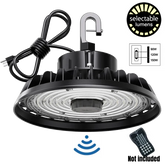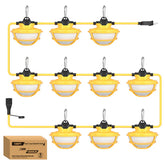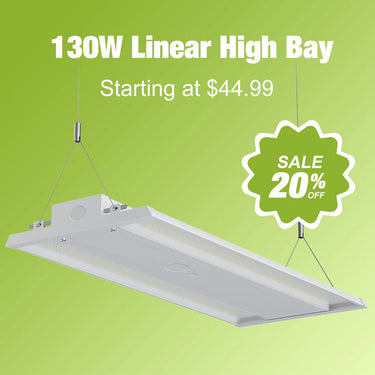Can High Bay Lights Be Used in Outdoor Applications?
by
NioJaydon
29 Aug 2025
High bay lights are traditionally associated with indoor spaces—warehouses, manufacturing plants, and gymnasiums—where their ability to illuminate tall, open areas shines. But as outdoor spaces like loading docks, sports fields, and industrial yards demand powerful, long-lasting lighting, many facility managers wonder: Can high bay lights work outdoors?
The short answer is yes—but only if you choose the right fixtures and account for outdoor-specific challenges (e.g., rain, dust, temperature extremes). Not all high bay lights are built for the outdoors; using an indoor-only model outside will lead to premature failure, safety hazards, or poor performance. Below’s a detailed breakdown of when, how, and why high bay lights can excel in outdoor applications, plus key factors to consider before installation.

1. First: Why High Bay Lights Are a Viable Option for Outdoors
Outdoor spaces with high ceilings or large open areas (e.g., 20+ feet tall) often struggle with traditional outdoor lighting solutions like floodlights or wall packs. Floodlights may lack the reach to cover wide areas evenly, while wall packs fail to illuminate spaces far from walls. High bay lights solve these issues by combining three outdoor-friendly strengths:
- Powerful, Long-Reaching Light: High bay lights (especially LED models) deliver high lumens output (12,000–36,000 lumens) and optimized beam angles—perfect for covering large outdoor zones like shipping yards or sports fields without dark spots.
- Durable Construction: Modern outdoor-rated high bays are built with rugged materials (aluminum housings, shatterproof lenses) that resist rust, impact, and UV damage—critical for withstanding wind, rain, and debris.
- Energy Efficiency & Long Lifespan: LED high bays use 50–70% less energy than traditional outdoor lights (e.g., metal halide floodlights) and last 50,000–100,000 hours (5–10 years). This reduces maintenance costs—especially important for hard-to-reach outdoor fixtures (e.g., mounted on 30-foot poles).

2. Which Outdoor Applications Benefit Most from High Bay Lights?
High bay lights aren’t a one-size-fits-all outdoor solution—they excel in specific spaces where height, coverage, and durability are priorities. Here are the most common outdoor uses:
Loading Docks & Shipping Yards
Loading docks require bright, consistent light for 24/7 operations (e.g., unloading trucks, inspecting cargo). High bay lights mounted on overhead structures or tall poles (20–30 feet) provide uniform coverage across the dock, eliminating shadows that could hide hazards (e.g., loose pallets, wet floors). Their high CRI (Color Rendering Index, 80+) also helps workers distinguish between package labels or cargo colors—reducing errors.
Outdoor Sports Facilities
Gymnasiums use high bays indoors, so it’s no surprise they work for outdoor sports like tennis, basketball, or small soccer fields. Wide-beam high bays (90°–120°) mounted on poles (25–35 feet) deliver glare-free light that covers the entire playing surface, avoiding the “hot spots” common with floodlights. LED high bays also avoid the warm-up time of metal halide lights—critical for evening games that start on short notice.
Industrial Yards & Construction Sites
Industrial yards (e.g., for storing heavy equipment) and construction sites need lighting that can withstand dust, vibration, and harsh weather. High bay lights with high IP ratings (IP65+) and anti-vibration designs hold up to machinery movement and debris, while their narrow or medium beam angles (30°–60°) focus light on work zones (e.g., equipment storage, construction phases) without wasting brightness.
Covered Outdoor Spaces
Patios, pergolas, or covered parking areas with tall ceilings (20+ feet) often use high bays for ambient lighting. These spaces are partially exposed to the elements, so outdoor-rated high bays with weather-resistant housing protect against rain and humidity while providing a warm, even glow for gatherings or parking.

3. Key Features That Make High Bay Lights Suitable for Outdoors
Not all high bays work outdoors—you need to prioritize these four features to ensure performance and safety:
IP Rating (Ingress Protection): Non-Negotiable for Outdoor Use
The IP rating measures a fixture’s resistance to dust and water—the single most important factor for outdoor high bays. Look for:
- IP65 or Higher: This rating means the fixture is dust-tight (6) and protected against low-pressure water jets (5)—ideal for most outdoor spaces (loading docks, sports fields).
- IP67 for Wet Environments: For areas exposed to heavy rain, standing water, or washdowns (e.g., outdoor food processing yards), choose IP67—these fixtures are dust-tight and can withstand temporary submersion (up to 1 meter for 30 minutes).
- Avoid IP44 or Lower: These are indoor-only ratings—they’ll let in dust and water, leading to short circuits or rust.
Weather-Resistant Materials
Outdoor high bays need materials that stand up to the elements:
- Housings: Aluminum is preferred—it’s lightweight, rust-resistant, and dissipates heat well (critical for LEDs). Avoid plastic housings, which can crack in extreme cold or fade in UV sunlight.
- Lenses: Shatterproof polycarbonate lenses (vs. glass) resist impact from debris (e.g., wind-blown branches) and won’t break if the fixture is bumped.
- Seals & Gaskets: Look for silicone or EPDM gaskets around the lens and housing—these create a tight seal to keep out moisture and insects. Over time, these gaskets may degrade, so choose fixtures with replaceable seals for long-term maintenance.
Temperature Tolerance
Outdoor temperatures swing from freezing winters to scorching summers—high bays must operate reliably in these ranges. Most LED high bays have a temperature rating of -4°F to 122°F (-20°C to 50°C)—sufficient for most climates. For extreme regions (e.g., sub-zero winters in Canada, hot deserts in Arizona), look for fixtures with extended temperature ranges (-40°F to 140°F/-40°C to 60°C).
Anti-Glare & Wind Resistance
- Anti-Glare Lenses: For outdoor spaces like sports fields or loading docks, glare can blind workers or athletes. Choose high bays with diffused lenses or frosted covers that scatter light evenly, reducing glare.
- Wind-Resistant Mounting: High bays mounted on poles or overhead structures need secure mounting hardware (e.g., heavy-duty brackets, reinforced poles) that can withstand strong winds (check local wind speed ratings—aim for fixtures rated for 90+ mph winds in hurricane-prone areas).

4. Common Mistakes to Avoid When Using High Bay Lights Outdoors
Even with the right fixtures, poor installation or planning can ruin outdoor performance. Watch for these pitfalls:
Using Indoor-Only High Bays
This is the biggest mistake. Indoor high bays lack IP protection and weather-resistant materials—exposing them to rain or dust will cause short circuits, corroded components, or complete failure within months. Always check the product label for “outdoor-rated” or IP65+ before buying.
Ignoring Beam Angle for Outdoor Space Size
Outdoor spaces vary widely in size—using the wrong beam angle wastes light or creates dark spots:
- Too narrow (15°–30°): Good for tall poles (35+ feet) but will leave wide gaps between fixtures in large yards.
- Too wide (90°–120°): Great for medium-height poles (20–25 feet) but will be too dim for tall structures.
Fix: Calculate your space’s width and pole height—use a beam angle calculator (many manufacturers offer free tools) to find the right fit.
Skipping Proper Mounting
Outdoor high bays are often mounted on tall poles or overhead beams—loose mounting can lead to the fixture swaying in wind, damaging wires or the fixture itself. Always use manufacturer-recommended mounting hardware and have a professional install poles (ensure they’re anchored deep enough in concrete to resist tipping).
Neglecting Winter Maintenance
Snow and ice can accumulate on outdoor high bays, blocking light and adding weight to the fixture. After snowstorms, gently brush off snow from the lens (use a soft brush—avoid sharp tools that scratch the surface). For icy conditions, choose fixtures with heated lenses (optional feature) to prevent ice buildup.

5. Comparing High Bay Lights to Other Outdoor Lighting Options
Is a high bay light the best choice for your outdoor space? Here’s how it stacks up against common alternatives:
|
Lighting Type
|
Best For
|
Pros
|
Cons
|
|
LED High Bay Lights
|
Tall, open outdoor spaces (20+ ft)
|
High lumens, energy-efficient, long lifespan
|
More expensive upfront than floodlights
|
|
Floodlights
|
Small outdoor areas (under 20 ft)
|
Affordable, easy to install
|
Poor coverage for large spaces, more glare
|
|
Wall Packs
|
Areas near walls (e.g., building exteriors)
|
Low profile, focuses light outward
|
Can’t reach far from walls, creates dark spots
|
|
Remote outdoor areas (no power)
|
No electricity costs
|
Less lumens, dependent on sunlight
|

For most tall, large outdoor spaces (e.g., loading docks, sports fields), high bay lights outperform floodlights or wall packs in coverage and efficiency—even with a higher upfront cost.
High bay lights can absolutely be used in outdoor applications—they’re a powerful, durable solution for tall, open spaces that need consistent, energy-efficient lighting. The key is to choose outdoor-rated fixtures with IP65+ protection, weather-resistant materials, and the right beam angle for your space. By avoiding common mistakes (e.g., using indoor fixtures, poor mounting) and prioritizing maintenance (e.g., cleaning snow, replacing gaskets), you’ll get years of reliable performance from your outdoor high bays. Whether you’re lighting a loading dock, sports field, or industrial yard, high bay lights offer a versatile alternative to traditional outdoor lighting—proving they’re not just for indoor use anymore.
Tags:

















